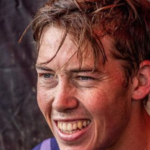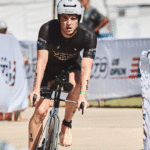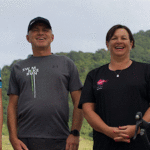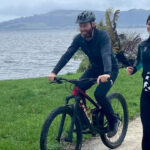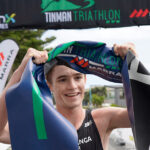Photos courtesy SuperLeagueTriathlon.com
By Kent Gray/Triathlon.kiwi
As the champion elect of Super League Triathlon (SLT) and the World Triathlon Championship Series (WTCS) pole-sitter, Hayden Wilde’s stock continues to rise and rise as the 2022 World Triathlon season approaches its crescendo.
But what of Tayler Reid and Nicole van der Kaay, the next most visible Kiwis racing in the elite echelon of short-distance triathlon? How are Tri NZ’s power couple tracking with a view to November’s WTCS decider in Abu Dhabi and beyond to the Paris 2024 Olympics where individual and Mixed Team Relay medals are clear targets?
To find out, Triathlon.kiwi didn’t have to look far. Stephen Sheldrake is not only Tri NZ’s Gisborne-based National Performance & Planning Manager, he coaches both Reid and van der Kaay. Having spent a good chunk of the past Northern Hemisphere summer overseeing their Commonwealth Games lead-in at Tri NZ’s Banyoles training base in Spain, no-one is better served to place context around the duo’s performances this season or to define the areas where improvement is needed.
On the surface, both are trending nicely with Reid fourth overall and tied atop the individual swim standings with South African Jamie Riddle heading into the penultimate event of the SLT season in Toulouse on Monday (12.01am Sky Sport 2/Channel 52). Van der Kaay, meanwhile, is eighth in the women’s rankings with Toulouse and the SLT decider in Neom, Saudi Arabia (Oct.29) a chance to continue her steady progress.
Ultimately though, it is the next WTCS race, sandwiched between the two SLT events, that Sheldrake is most looking forward to. Olympic and Commonwealth Games medallist Wilde might have the luxury of being able to sit out the Oct. 8 race in Cagliari and again at the WTCS regular-season finale in Bermuda on Nov. 5-6, but for Reid and van der Kaay, there are vital Paris Olympic qualification points up for grabs. And for Sheldrake, Cagliari presents as a more accurate measure of where both are at ahead of the WTCS finale in Abu Dhabi (Nov.24-26) as opposed to the short-burst, mixed format SLT.
“Cagliari is an Olympic distance race and it’s been a long time since they’ve done an Olympic distance race,” said Sheldrake. “So it’s really just about seeing where they are at in regards to Abu Dhabi.”
Tayler Reid

Sheldrake recalls mapping out a 12-year plan, up to the 2024 Olympic Games, with Reid way back in 2012 when he first started working with the Gisborne Boys’ High School prospect.
It’s no stretch to say Reid, now 25, has ticked off many of the goals they targeted along the way including becoming U-23 world champion and a team relay bronze medallist at the Gold Coast Commonwealth Games alongside van der Kaay, Andrea Hansen (nee Hewitt) and Ryan Sissons later in 2018.
Reid was 18th on Olympic debut in Tokyo two years ago and, after finishing 11th individually on the Gold Coast four years earlier, had high hopes heading into the Birmingham Commonwealth Games this past July.
Those hopes were dashed though when Reid was struck down by COVID-19 before WTCS Hamburg. With that, three critical weeks of training and a vital lead-in race to Birmingham went out the window and his eventual eighth placing at the Comm Games, a spot behind Kiwi team-mate Dylan McCullough, was probably as much as he could have hoped for given how under-cooked he was prep wise. Reid was out on the bike with Wilde and co but had to push so hard in an attempt to stay in the medal hunt, he had little juice left for the run.
Fast-forward to the Super League and eighth, sixth and seventh placings in London, Munich and Malibu respectively has given Reid an outside shot at an overall podium spot.

“The Super League is about being consistent, getting consistent results. Last year he was a little flat for the first couple of events and came right but this one, we learnt from last year in terms of the training he’s got to keep doing in between events,” Sheldrake said.
“It’s a fine line between how much training you do, do, versus tapering for each event. You know, if you just keep tapering you just de-train throughout the whole month. So good experience from last year… overall, yeah, happy.”
There’s also the SLT’s US$15,000 swim ‘Blue Jersey’ to try and win so don’t be surprised to see Reid again pushing Aussie Matt Hauser and Riddle hard in Toulouse and Neom. For Sheldrake though, delivering Reid to the start of the run in Cagliari and Abu Dhabi fresher is the key “work-on”.
“One of the issues Tayler had in the past, he grew up as a swimmer and knew he was a good swimmer, running was his weakness so he felt like he had to break out on the bike all the time. It tended to deliver himself to the run tired because he tried to get away all the time and he never ran to his potential,” Sheldrake said.
“I always say triathlon is all about delivering yourself to the run in the best possible shape. If you’ve got 20 bucks to spend on triathlon and you spend eight bucks on the swim and nine bucks the bike, that leaves you three dollars for the run. It doesn’t matter if you are a world-class runner but …
“Tayler led the Commonwealth Games swim out, he tends to lead a lot of the races out and there is only one place you can go when you lead the race out and you haven’t grown up as a runner.”
Encouragingly, Sheldrake has data that proves Reid can mix it in the final race discipline, albeit with a little more race craft beforehand.

“I’ve seen running sessions fresh that showed he was a very good runner comparative to other very good runners so, whilst we work on the running with specific mileage through base periods of the year in New Zealand, and running with faster runners and doing strength and conditioning programmes to allow him to run faster, it’s the overall picture.
“It’s about, I’m a good swimmer but do I need to lead the swim out, do I sit second wheel on the swim and save energy and on the bike can I just sit in? A good example of that was last year at the WTCS finale in Edmonton where he managed to get in a group where he was just sitting in, not doing much work on the bike and he managed to run seventh.”
So, what about a longer-term vision of Reid’s potential?
“It’s to improve on that 18th place from Tokyo,” Sheldrake continued. “You know, Tayler’s had a very linear pathway as an athlete. I remember sitting down with him in 2012, so 10 years ago now, and we wrote a 12-year pathway and it was like year one, U-19 worlds and he did three years of that and it was about improving year on year. And then he did U-23s and he won world U-23s in 2018 and then it was about Commonwealth Games in 2018 and he won a medal there in the relay, and then it was about Tokyo and it was about going to a first Olympics and it was about experiencing that and blooding himself to medal in Paris.
“The goal was always to medal at the Olympics and whether it’s in the teams or whether he can be good enough as an individual in the next two years is to be seen but that’s always been the plan for him.”
Nicole van der Kaay

When Sheldrake took on van der Kaay in 2019, he inherited an athlete that had been consistently hampered by injury, in part because of the Taupo starlet’s heavy race schedule as a younger athlete. But hiding behind the slow development was a genuine star-in-waiting.
“When she can put in consistent training without any injuries or niggles, she’s a world-class athlete. She proved that last year when she podiumed at Hamburg WTCS, she got a silver there,” Sheldrake says.
There was frustration in her ninth place finish in Birmingham as van der Kaay had been running fifth only to be slapped with a 10 second penalty for an earlier helmet violation, something of a recurring nightmare for the Kiwis at the Comm Games. Like Reid, it was “probably not a true reflection of that race…but that’s where she ended up and that is her placing, don’t get me wrong…”
In Super League, van der Kaay has placed 10th, 10th and 9th, consistently fighting off the threat of in-race relegation after struggling in the swim before running to highly respectable top 10s. Therein lies van der Kaay’s Achilles heel as a triathlete, and, conversely, the area open for great performance strides.

“There is still a lot of work to do with her swimming. A lot of the time she can kind of fake her way through 750m to be close enough in a sprint race and you get onto the right [cycle] bunch. But, you know, the Olympic distance they’re becoming few and farther opportunities throughout the year.
“She needs to spend a bit more time in the strength and conditioning programme, get a little bit stronger, the ability to deal with the hustle and bustle with 60 other girls around you trying to get to the first buoy. It’s definitely a work on and will continue to be a work on as she hasn’t grown up as a swimmer but there is a number of things she can continue to do that will allow her to become better. It’s just that ability to be consistent.”https://www.instagram.com/p/Cd7eWpZv0wm/embed/captioned/?cr=1&v=14&wp=675&rd=https%3A%2F%2Foldsite2022.triathlon.kiwi&rp=%2Fhow-tri-nzs-power-couple-tayler-reid-and-nicole-van-der-kaay-are-trending-towards-the-2024-paris-olympics%2F#%7B%22ci%22%3A0%2C%22os%22%3A1558.199999999255%2C%22ls%22%3A1480%2C%22le%22%3A1520.800000000745%7D
As Sheldrake preaches, tri is all about delivering yourself to the run in the best possible shape. With swim improvement, he knows van der Kaay “will run well over any distance.”
“She’s good enough to go be part of a relay team and medal at the Olympics. As an individual, a little the same as Tayler, if she can put in another two years of consistent training without being injured too often, she’d good enough to be world class on her day. A medal. Absolutely. Why not?”

